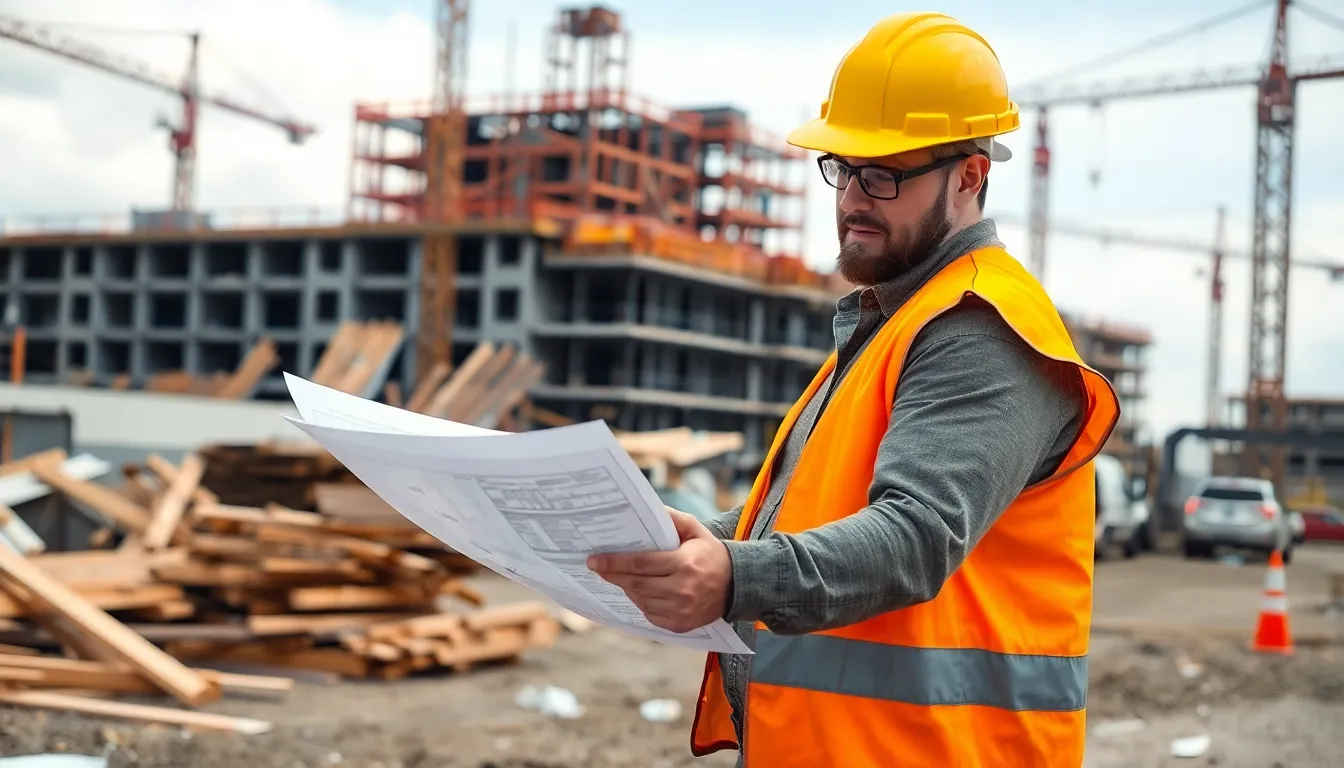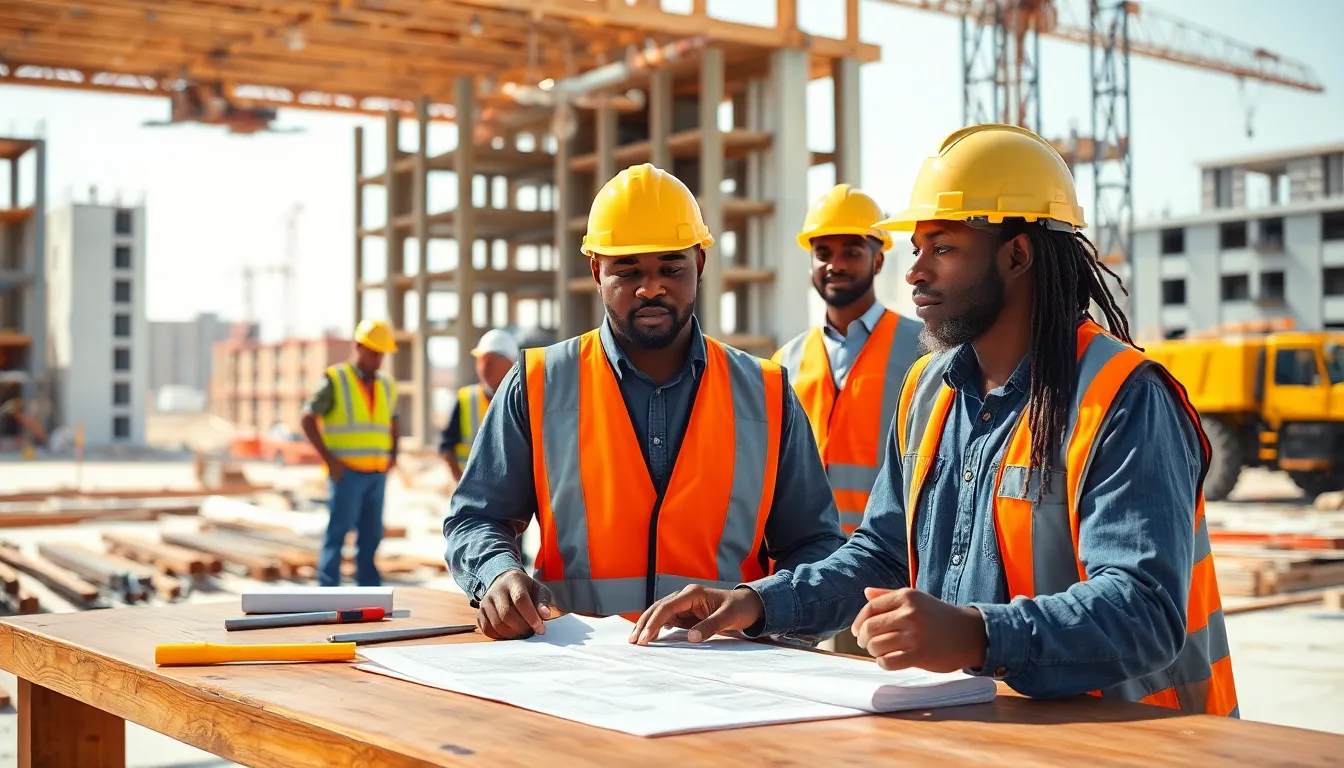Table of Contents
ToggleBuilding a structure is no small feat. It’s a blend of creativity, precision, and a sprinkle of chaos. But what happens when the unexpected strikes? Enter building construction insurance—the superhero of the construction world, swooping in to save the day when things go awry. From accidents on-site to those pesky weather surprises, this insurance is the safety net every builder needs.
Imagine pouring your heart and soul into a project only to face unforeseen challenges. With the right coverage, builders can focus on what they do best—creating amazing spaces—without losing sleep over potential mishaps. So why take unnecessary risks? Embracing building construction insurance is like wearing a hard hat for your finances, ensuring you’re protected while you lay those bricks and beams. It’s time to build confidently, knowing you’ve got a safety net ready for anything.
Overview of Building Construction Insurance
Building construction insurance serves as a vital safety net for builders, protecting them from a variety of risks during the construction process. This form of insurance ensures financial security, enabling builders to concentrate on their projects without undue stress about potential setbacks.
Importance of Construction Insurance
Construction insurance holds significant importance in the industry. It mitigates financial losses resulting from accidents, theft, or property damage. Coverage allows builders to complete projects as planned, regardless of unforeseen challenges. Without this insurance, the financial burden of accidents could jeopardize a builder’s enterprise. Financial stability depends on having this safety measure in place, promoting confidence among builders and clients alike.
Types of Construction Insurance
Builders can choose from several types of construction insurance to suit their needs. General liability insurance protects against third-party claims for bodily injury or property damage. Professional liability insurance covers mistakes or negligence related to professional services. Builder’s risk insurance focuses on construction project-related hazards, covering materials, equipment, and structures. Workers’ compensation insurance safeguards against employee injury, ensuring workers receive medical benefits. Each type of insurance provides targeted protection, enabling builders to select coverage that best fits their specific risks.
Key Coverages in Building Construction Insurance


Building construction insurance provides essential coverage options tailored for various risks encountered during construction projects. Key coverages include general liability insurance and workers’ compensation insurance, both fundamental in safeguarding builders from unexpected events.
General Liability Insurance
General liability insurance protects builders against claims arising from property damage or bodily injury that occurs during construction. This coverage extends to incidents affecting third parties on the construction site, such as visitors or vendors. Policies typically cover legal fees, medical expenses, and settlements or judgments. Coverage limits often range from $1 million to $2 million per occurrence, providing critical financial security. Additionally, purchasing this insurance is essential for overall operational risk management, ensuring builders can proceed without excessive worry about potential claims.
Workers’ Compensation Insurance
Workers’ compensation insurance covers employees injured on the job, ensuring they receive medical care and compensation for lost wages. This protection is vital in the construction industry, where accident rates can be significant. Policies follow state-specific regulations and typically cover various expenses, including hospital bills and rehabilitation costs. Benefits range significantly, often between $150,000 and $1 million per incident. Ensuring compliance with state laws regarding workers’ compensation is crucial for builders looking to maintain safe work environments while protecting their financial interests.
Factors Affecting Insurance Costs
Several elements determine the costs of building construction insurance. Key factors include project size, location, and the safety record of the construction site.
Project Size and Scope
Project size significantly impacts insurance premiums. Larger projects require more materials and labor, increasing exposure to risks. Insurance providers assess the overall project scope to estimate potential claims. Complex projects may incorporate specialized equipment or unique structures, further elevating costs. More workers on-site raises liability risks, resulting in higher worker’s compensation insurance needs. Investing in comprehensive insurance coverage is essential for large-scale projects.
Location and Safety Record
Location plays a crucial role in determining insurance costs. Areas with high crime rates or adverse weather conditions generally incur higher premiums. Insurers evaluate the local environment, considering factors like flood zones, earthquake risks, or tornado-prone regions. Additionally, the safety record influences rates; sites with a history of accidents or claims typically face elevated premiums. Maintaining a strong safety track record can lower overall insurance costs and improve coverage options.
Choosing the Right Insurance Provider
Selecting an insurance provider requires careful consideration of various factors. Evaluating a company’s reputation and experience within the construction industry plays a central role in this process.
Evaluating Insurance Companies
Researching insurance companies provides insight into their reliability and customer service. Specific factors, such as financial stability and claims process efficiency, determine a company’s ability to support policyholders. Checking online reviews and testimonials from past clients offers firsthand accounts of experiences. Comparing multiple insurance providers helps builders identify the best fit for their needs. Engaging with local agents allows for personalized recommendations and clarifies coverage specifics.
Understanding Policy Terms
Understanding policy terms ensures builders comprehend their coverage fully. Key components, including deductibles, coverage limits, and exclusions, significantly impact protections offered. Evaluating these terms helps tailor decisions to specific project needs. Clarity regarding claim procedures is essential for smooth processing when challenges arise. Seeking explanations from agents fosters knowledge and confidence in the chosen policies. Adjusting coverage as project scopes change keeps builders adequately insured throughout the construction process.
Common Exclusions in Construction Insurance
Construction insurance often excludes certain risks that can pose significant challenges to builders. Understanding these exclusions helps builders prepare for potential gaps in coverage.
Natural Disasters
Natural disasters frequently result in extensive damage, and many construction insurance policies exclude such events. Earthquakes, floods, and hurricanes often fall outside standard coverage terms. Builders must explore specific policies designed for these risks or consider purchasing separate coverage. In regions prone to severe weather, investing in additional disaster coverage becomes vital to safeguard project investments.
Negligence Claims
Negligence claims typically don’t fall under standard construction insurance protections. If a builder or subcontractor fails to meet industry standards or local building codes, the insurance may not cover resulting damages. Legal expenses and settlements from negligence claims can prove costly, emphasizing the importance of maintaining adherence to safety regulations. Builders should proactively implement quality control measures to mitigate the risk of negligence cases arising.







